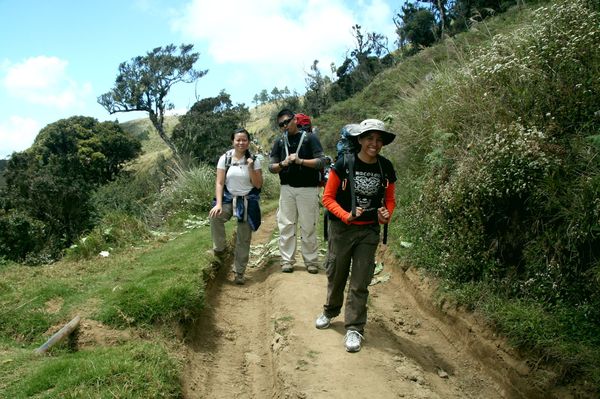Mt. Pulag is the third-highest mountain in the Philippines, standing at 2,922 meters above sea level. It is situated within the municipalities of Buguias, Kabayan, and Bokod in Benguet, Tinoc in Ifugao, and Kayapa in Nueva Vizcaya.

The mountain is home to 528 documented plant species, including the endemic dwarf bamboo and Benguet pine. It also hosts 33 bird species and several animals such as the Philippine Deer, the cloud rat, and the long-haired fruit bat.
Mt. Pulag is also a habitat for various ethnic groups like the Ibaloi, Kalanguya, Kankana-ey, and Ibanag, with many considering the mountain as sacred land.
The mountain has become popular among mountaineers and enthusiasts, thanks to the captivating "sea of clouds" phenomenon, in addition to its lush mossy forest and grassland summit.
Climbing Mt. Pulag
There are four major trails leading to the summit: Ambangeg, Akiki, Tawangan, and the Ambaguio trail from Nueva Vizcaya. These trails are managed by the Mount Pulag National Park, under the Department of Environment and Natural Resources.
Which trail to choose?
For beginners, the Ambangeg-Ambangeg Trail or the executive trail is recommended. It is the easiest trail, starting at an already high altitude, the Badabak Ranger Station, with the summit approximately 8 kilometers from this jump-off point.
The trail is relaxing, with few steep parts.


Climbers can rest at Camp 1, which has a hut,
Camp 2 is the ideal camp location, offering a nearby water source, latrines, and a breathtaking view of the grassland. If you're fortunate, you might witness an amazing sunset.
The summit from Camp 2 is approximately a 2-hour hike. Campers usually leave an hour or two before dawn to catch the glorious sunrise at the summit of Mt. Pulag.
What to expect?
Prepare for really cold weather, especially from December to February, with temperatures potentially going negative. Although it doesn't snow, ice particles may form on the grassland during exceptionally cold months. Hypothermia is a possibility, and individuals with asthma or other pulmonary conditions should seek a doctor's advice. Be ready for possible allergies.
The jeepney ride from Baguio to DENR can also be nauseating, so be prepared.
What to wear? What to pack?
Prepare for extremely cold weather, and jackets are a must. Pack bonnets, scarves, gloves, socks, and thermal underwear if you have them, along with your own medication and a first aid kit.
For the trek, wear trekking shoes, lightweight pants, and a dri-fit shirt. Bring your sleeping bag and earth pad. If you are joining a group, coordinate on food and other equipment like a tent, cookset, and stove. Ensure everything is waterproofed, and don't forget to bring enough trail food.
How to arrange a climb?
Jeepneys must be arranged from Baguio to Badabak Ranger Station. It is best to leave Manila at night and arrive in Baguio City before dawn, then travel from Baguio to the jump-off. The ride takes four to five hours, including a breakfast stop at Jangjang, a photo stop at Ambuklao Dam, and a crucial briefing at the DENR station. All climbers are required to attend this briefing, where you'll learn a lot about Mt. Pulag and mountain climbing ethics.
Unfortunately, Mang Roger passed away last year, but his business was taken over by cousins, who use the same number according to friends (0920-8068656). Norton Buses (Northern Transit Terminal Station, Magsaysay Avenue) bound for Kabayan Benguet may also be taken.
Permits, guides, and porters, if needed, must be arranged in advance with Ms. Abas (0919-6315402). Please use a Smart phone when texting Ms. Abas. Most guides are self-contained and have a hut to stay at Camp 2, but allocate food for guides and porters.
How much to climb Mt. Pulag?
Jeepney rental to and from the ranger station ranges from P9,500 to 10,000. The entrance fee is Php 100.00 per head, Camping Fee is Php 50.00 per head, Green fee is Php 50.00 per head, and Guide fee is Php 100.00 per head.
When to climb Mt. Pulag?
Mt. Pulag is accessible year-round. Climbing during the early part of the year, when the weather can be extreme, is recommended for those up for the challenge. The sea of clouds is magnificent during clearing. Summer months are also okay, but the sea of clouds may not be as fantastic.
During extremely bad weather, like the rainy season, jeepneys may not reach the ranger station, and clear skies may be elusive.









7 comments
Wow abot kamay ang mga ulap. I like the images especialy the images with formation of clouds.
ReplyDeleteSee the amazing all season destination Thunderbird Casino
hello. good day! i am mejette c. apilas of the Benguet Tourism Office. we, in the Benguet Tourism Office, would like to ask for PERMISSION TO USE some of your pictures, those which were taken here in Benguet, for presentations and promotions of the existing sites here in our Province. Rest assured that such pictures taken by you will be used only for the reasons stated. :) thanks much and we hope that you will allow us to use such beautiful pictures! :)
ReplyDeleteNo problem. Would appreciate a photo credit though. Thanks!
ReplyDeleteno problem ma'am.. thanks very much! :)
DeleteHi Kelly, I would like to know kung safe ba umakyat sa Mt. Pulag with a toddler na kasama mga 3yrs.old ang age. Any advise? Thank you!
ReplyDeleteI already saw a 3 year old climb Mt. Pulag but I can't say it is safe. There are still risks involved.
DeleteHello po,, saan mo pwde mag rent ng tent good for 3 at magkano po?
ReplyDelete